BadwaterJournal.com
WHAT UNSUSTAINABLE URBAN GROWTH LOOKS LIKE
BadwaterJournal.com
WHAT UNSUSTAINABLE URBAN GROWTH LOOKS LIKE
Published online at Louisville, Kentucky USA -
An independent, secular, contemporary journal of political and environmental issues dedicated to peaceful reduction of human impacts on Earth


20 year fair housing plan
as an inadequate Metro Government apology for slavery legacy
<http://www.oxfam.org/en/policy/working-for-the-few-economic-inequality>
WORKING FOR THE FEW
Political capture and economic inequality
OXFAM January 2014 report
“Given the scale of rising wealth concentrations, opportunity capture and unequal political representation are a serious and worrying trend. For instance:
• Almost half of the world’s wealth is now owned by just one percent of the population.
• The wealth of the one percent richest people in the world amounts to $110 trillion. That’s 65 times the total wealth of the bottom half of the world’s population.
• The bottom half of the world’s population owns the same as the richest 85 people in the world.
• Seven out of ten people live in countries where economic inequality has increased in the last 30 years.
• The richest one percent increased their share of income in 24 out of 26 countries for which we have data between 1980 and 2012.
• In the US, the wealthiest one percent captured 95 percent of post-financial crisis growth since 2009, while the bottom 90 percent became poorer.
This massive concentration of economic resources in the hands of fewer people presents a significant threat to inclusive political and economic systems. Instead of moving forward together, people are increasingly separated by economic and political power, inevitably heightening social tensions and increasing the risk of societal breakdown.”
<http://caricom.org/jsp/pressreleases/press_releases_2013/pres285_13.jsp>
(10 December 2013)
CARICOM REPARATIONS COMMISSION PRESS STATEMENT Delivered by Professor Sir Hilary Beckles (Chairman) on behalf of the CARICOM Reparations Commission Press Conference Regional Headquarters, UWI
The Thirty-fourth Meeting of the Conference of Heads of Government which was held in July 2013 in Trinidad and Tobago, agreed to set up National Committees on Reparations, to establish the moral, ethical and legal case for the payment of reparations by the former colonial European countries, to the nations and people of the Caribbean Community, for native genocide, the transatlantic slave trade and a racialized system of chattel slavery.
Heads of Government further agreed to establish a CARICOM Reparations Commission comprising the Chairs of the National Committees and a representative of the University of the West Indies (UWI), which would report directly to a Prime Ministerial Sub-committee on Reparations, chaired by the Prime Minister of Barbados, the Hon. Freundel Stuart.
To date, National Reparations Committees have been established in 8 Member States, namely Antigua and Barbuda, Barbados, Belize, Guyana, Jamaica, St. Lucia, St. Vincent and the Grenadines and Suriname.
The Executive of the CARICOM Reparations Commission met on December 9, 2013 in Jamaica at the Regional Headquarters of the University of the West Indies in order to define and set in train its plan of action.
It did so within the context of the global celebration of the life of Nelson Mandela, who, by his sacrifice and teachings, provided the world with a moral and ethical framework within which the diplomatic and political search for truth, justice, and reconciliation can be attained. The Commission affirmed its commitment to the principles inherent in the living legacy of Mr. Mandela.
The Commission affirmed the argument that Caribbean societies have been built upon transatlantic slave trading and chattel slavery, which have been declared by the United Nations as crimes against humanity. These societies are uniquely placed to advance the global cause of truth, justice, and reconciliation, within the context of reparatory justice for the victims and their descendants who continue to suffer harm as a consequence of these crimes.
The Commission called upon the former slave-owning nations of Europe - principally Britain, France, Spain, Portugal, the Netherlands, Norway, Sweden and Denmark - to engage Caribbean governments in reparatory dialogue to address the living legacies of these crimes.
The Commission noted that Caribbean societies also experienced the genocide of the native population, which was also declared a crime against humanity by the United Nations. The victims of these crimes and their descendants were left in a state of social, psychological, economic and cultural deprivation and disenfranchisement that has ensured their suffering and debilitation today, and from which only reparatory action can alleviate their suffering.
Louisville Metro Government has no plan to eradicate the present day inequity that is the legacy of slavery
by Bud Hixson
In some 20 pages narrating a brief history of slavery, race relations and housing in ‘Making Louisville Home for Us All, A '20 Year Action Plan for Fair Housing' (hereinafter, The Plan) the writers understate the cultural injuries of slavery in Metro Louisville and omit critical aspects of the continuing exploitation of black bodies. The proposed 20 year Plan to achieve fair housing is not commensurate with the gravity of the injury done to the Descendants of Slaves in Louisville where slave pens held captives to be bartered for and sold down the river to the cotton plantations of the Mississippi Valley.
Slavery as genocide perpetrated by
white Europeans in America has left
indelible scars and was followed upon by
Jim Crow and New Deal era policies that
favored white advancement. Most
recently, the CARICOM group of
Caribbean nations recognizing the
legacy of economic depression in the
islands has formed a committee to
pursue economic development through
loan forgiveness and other incentives
from western governments that participated in the trans Atlantic slave trade.
The Commission stated its intention to call upon CARICOM Heads of Government to seek reparatory dialogue with the former slave-owning states of Europe, which were enriched by these crimes, with a view to seeking their support for the eradication of the legacy that serves to subvert the development efforts of national societies.
The aim is to eradicate the legacy of slavery that presently prevents social and economic advancement. While the educational and economic legacy is recounted in the Plan no ambitious program is planned to eradicate the legacy of slavery in West Louisville. The Plan should have set forth more fully the multi-faceted debilitation to enslaved peoples as a basis for understanding the persistent economic disparity.
The human suffering in public health, education, cultural institutions, cultural deprivation, psychological trauma and scientific and technical backwardness is not discussed in meaningful terms in The Plan. It makes no attempt to determine if the same social and psychological structures in the mentality of the dominant white culture that practices slavery exert a continuing influence on present day Metro Government policy. They do.
Politicians still appeal to the badges of privilege and race distinctions to maintain race and class distinctions, diminish the bloody history and nullify the impetus to fund adequate programs to end disparity. Metro Louisville is appropriately thought of as another third world nation with child poverty at 27%, colonized by first world corporate entities that make free use of the public revenues to advance corporate interests. We are expected to stay drunk on bourbon and basketball while working two jobs for minimum wage.
From the chronic disparity one can conclude, Metro policy is directed at continuing poverty and race disadvantage to maintain white control of the economic agenda. In Louisville we deplore the sad condition of West Louisville and document the bare highlights of its history but fall silent when the real institutions that cause and perpetuate disadvantage are exposed.
Capitalist business economic exploitation of slaves in the pre- and post civil war era and the continued low wage politics of today are at the heart of the issue. Even as leaders in Metro Council debate raising the minimum wage to a 'living wage' of some $ 10.00 an hour, no detailed information on local income disparity is produced. The historic contribution of slaves labor to the sports, racing, bourbon and tobacco industry fortunes is missing. Black bodies continue to be exploited in the NCAA system to build fortunes while their communities suffer widespread unemployment. The two highest paid employees in the state are sports coaches. See it HERE
The Plan notes:
The contribution of enslaved people to Kentucky’s infrastructure was immeasurable, including everything from clearing land to planting crops to building the earliest homes and businesses. Along with the tragic economic inequalities of slavery, ideas about black inferiority hardened as the new nation developed. It became easier for white Americans to maintain their commitments to freedom and equality even as they held people in bondage if they thought of those of African descent as somehow inferior. Those ideas became the basis for many societal beliefs and systems of doing business in the new nation. Pg 13.
The role of white social institutions as a cause of why we have failed continuously since 1865 to eliminate race disadvantage and discrimination is not explored in The Plan. The continuing usefulness to business enterprise of race and class distinctions and 'inferiority theory' is omitted. A frank confrontation with this truth would contribute to reframing local policy towards justice.
The control of whites over economic and transportation policy through major employers, through KIPDA, GLI and Metro Council of consolidated government is well known to the contributor, Metro Housing Coalition since they argued it strongly to KIPDA in its federal recertification process in 2010, but that account is absent from the Plan narrative.
"In response, KIPDA removed plans for light rail and rapid bus transit from Horizon 2030. Of some 540 public comments directed to KIPDA regarding this action, nearly 100 percent were opposed to removing the transit projects. KIPDA's Community Outreach Planner compiled hard copies of all the comments in a document totaling 247 pages and distributed them to the TPC members (Public comments are available at: http://www.kipda.org/files/ PDF/Transportation_Division/Comments/Public_Comments. pdf). Despite this public outcry, a total of $1.4 billion in advanced transit initiatives was removed from Horizon 2030. Nina Walfoort, a spokeswoman for the TARC, the public transportation agency that had recommended the initiatives, commented that the plan "should be a community decision, ..not something for the [federal government] to decide."
Social activists have consistently begged the economic planners to fund equity investment to end slavery legacy to no avail. The Plan published in June 2013 notes:
The legacy of centuries of racial discrimination that brought social and economic isolation to the west side of the city is reflected most sharply in two wider factors. One is education: more than 55 percent of East Louisvillians hold at least a Bachelor’s degree, whereas only 7 percent of West Louisvillians do.
And in those 22 West Louisville census tracts studied lie only 36 businesses, less than one-third of the 117 in their East End counterparts. Among these western businesses, the study found no hospitals, no sit-down restaurants, no motels and no movie theatres, but an overabundance of liquor stores and fast-food restaurants.
As these maps illustrate, the clustering of local poverty is largely consistent with concentrations of African Americans, disabled people, single-mother-headed households and homeless children. Also clustered in these neighborhoods are quality-of-life barriers such as higher rates of asthma, cancer and lead exposure; less access to healthy food and to health care and— not surprisingly—lower life expectancy
In 2011, 13 percent of Louisville Metro families had incomes below the poverty level ($23,021 for a family of 4), leaving a striking 27.5 percent—more than one-quarter—of all children in our county living in poverty.162 This appalling statistic deserves and demands greater public attention. Pg 44
The 2014 list of capital projects from Metro Government web site shows nothing that would reverse this condition. The 'Louisville Moves' transportation planning effort may find a need for a light rail transit system for poor people, but there's no guarantee it would be funded and built. Past experience indicates it will not.
There are no Metro Government capital projects specifically directed at the impoverished west end of sufficient scope and purpose to address 27% child poverty. $500 thousand is allocated to a West Louisville Land Assembly project to collect vacant properties for resale. The Metro economic development team headed by Ted Smith is focusing on other areas but has no West Louisville economic development plan.
The recent announcement that a WalMart regional big box store would open at 18th and Broadway should be seen as an attempt by the economic elite to continue the disintegration of the West Louisville black community by the well documented 'WalMart' effect that causes small retailers to lose business.
See Forbes, Tim Worstall, Of Course WalMart Destroys Retail Jobs: That's The Darn Point Of It All
The jobs offered by WalMart, clerical and shipping, will not add advanced training for higher income positions in manufacturing and are presumed to pay minimum wage --not a living wage.
No person in Metro Government has announced programs to:
• bring hundreds of blue collar jobs accessible by foot or public transit
• bring living wage jobs that address the education gap
• no detailed West Louisville economic plan to preserve neighborhood cohesion
The $ 1.2 billion east end bridge approved in July 2012 directly served economic expansion in white suburbs. It recognized the desirability of cross river connectivity in the immediate vicinity of FORD as a major regional employer and Clark County Indiana River Ridge Industrial park as a major industrial expansion area.
The Bridges Project was developed for more than a decade from 1997 to 2012 and included major state legislation to authorize a bi-state tolling authority to share toll revenue of the two bridges. When Metro government and the GLI elite wish to pursue economic goals to empower wealthy companies they move with focused determination and corral support from every agency. They show no indication of making the 27% poverty in West Louisville such a priority.
After the Plan reported to Metro Government:
In 2011, 13 percent of Louisville Metro families had incomes below the poverty level ($23,021 for a family of 4), leaving a striking 27.5 percent—more than one-quarter—of all children in our county living in poverty. This appalling statistic deserves and demands greater public attention. Pg 44
Mayor Fischer met with his counterpart in Lexington and announced in November 2013 the BEAM -Bluegrass Economic Advancement Movement. BEAM describes a new policy of regional planning and industrial development justifying pouring millions in tax incentives into major manufacturing industries located in the region.
It doesn't have specific provisions to address the unemployment or economic disparity in West Louisville by inducing jobs growth tailored to the area's educational needs. The BEAM focuses on building jobs that have a higher educational level achievement connected to target industries. Those jobs will be filled predominantly by white applicants. The BEAM appears to authorize the Mayor to concentrate economic development to serve the two city axis in the white suburban areas between Louisville and Lexington and the West Louisville area is left as an afterthought.
In January 2014, concurrent with an $ 80 million Westport Road Truck plant expansion the state of Kentucky granted Ford $ 50 million in tax incentives. The plant produces super duty Ford trucks and large SUVs. No discussion of the impact of granting an exemption from $ 50 million in taxes was in the press releases.
Because it obscures the social dynamics and fails to elucidate the actions of institutions that perpetuate structural racism, the Plan fails to set out a path for meaningful change. Nor is there any evidence that the writers obtained reliable commitments from Metro Government in exchange for a generic history that drains the impetus for immediate action. Subsequent policy decisions show Metro Government continues to ignore the legacy issues.
The Plan reflects the preferred version of history that reduces the injury to an inconsequentiality --less compelling than high tech economic expansion opportunities. The Plans authors clearly hope to achieve real progress in West Louisville but are reduced to apologizing for the continuing race disadvantage instead of announcing robust projects to address it.
"The persistence of residential segregation and other impediments to fair housing in Louisville is no accident, but the result of a wider system of structural racism on which many of Louisville’s housing policies and practices rest." Pg 8.
Money flows out of our pockets, black and white as a result of structural racism disadvantages. The dependence of racially segregated people on public relief and emergency hospitalization means hikes in the tax burden on the general public and leads to morbid growth of public safety agencies which now take more that $ 140 million in salaries from the annual Metro budget.
Elite business capture of spending policy maintains economic class and race disparity in a self serving scheme to depress wages, increase profits and results in astonishing income disparity. This is an international capitalist artifact where white privilege is perpetuated as prudent economic investment.
The Plan's attempt to set out the history of racist discrimination and resulting segregation should have shown how that history caused malignant growth of police and corrections agencies into a police industrial complex in this community that punishes people in poverty disproportionately of color instead of rebuilding impoverished areas.
Thus the Plan is not a comprehensive program for slave reparations in recognition of the legacy of race disadvantage or of the debilitating impact of existing structural racism. Its not a robust plan for extending the tools of economic development into the areas affected by structural racism. Its appears to be an apology by Metro Government through a third party, but lacks explicit terms for understanding the scope of the cultural injury and shields the guilty Metro Council and white institutions from liability to address the social disease. The 20 year plan proposal leaves 25% of children in poverty.
In the April 3, 1968 speech before his assassination, Martin Luther King arguing for support of the Memphis sanitation workers described the cause as one for justice now. The Promised Land he spoke of is equality in the current economic system not white robes in the beyond.
“But I want to thank all of them, and I want you to thank them because so often preachers aren't concerned about anything but themselves. [Applause] And I'm always happy to see a relevant ministry.
It's all right to talk about long white robes over yonder, in all of its symbolism, but ultimately people want some suits and dresses and shoes to wear down here. [Applause]
It's all right to talk about streets flowing with milk and honey, but God has commanded us to be concerned about the slums down here and His children who can't eat three square meals a day. [Applause]
It's all right to talk about the new Jerusalem, but one day God's preacher must talk about the new New York, the new Atlanta, the new Philadelphia, the new Los Angeles, the new Memphis, Tennessee. [Applause]
This is what we have to do.”
The movement in 1968 would have mobilized to oppose a 20 year plan where such race disparate poverty exists while corporate billionaires reap huge profits and enjoy millions in tax abatements.
The 20 Year Action Plan demonstrates a fearful hesitance to accurately detail the relevant history and lacks any framework for supporting the idea that revision of Euclidian zoning rules over 20 years will meaningfully alleviate poverty, achieve economic opportunity or provide trans-generational justice for a people subjected to a program of genocide. The 20 year action plan is an inadequate and inappropriate response to the history and legacy of race discrimination in Metro Louisville.
Bud Hixson is a private attorney working
with the American Slaves Inc. movement in Louisville, KY
seeking a national re-investment program to eradicate the legacy of slavery disadvantages in Descendants of Slaves communities.
half the urban particulate air pollution from cars comes from a small set of high emissions vehicles
air pollution haze from fine particulate over Louisville
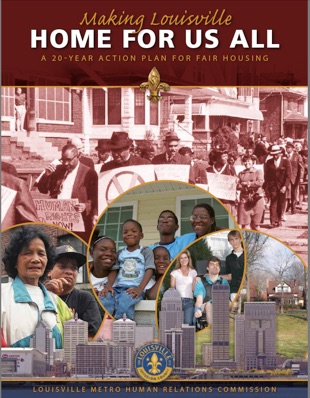
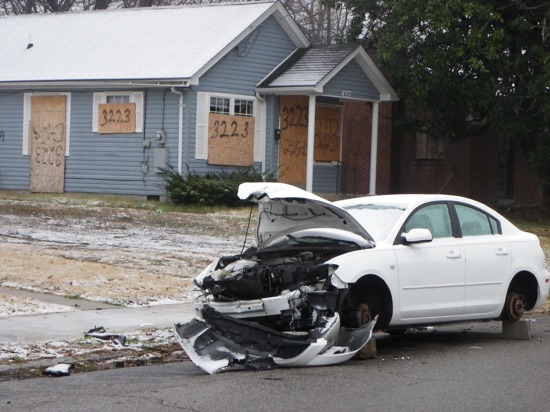
Get the Report HERE

KIPDA Map of transit boarding frequency
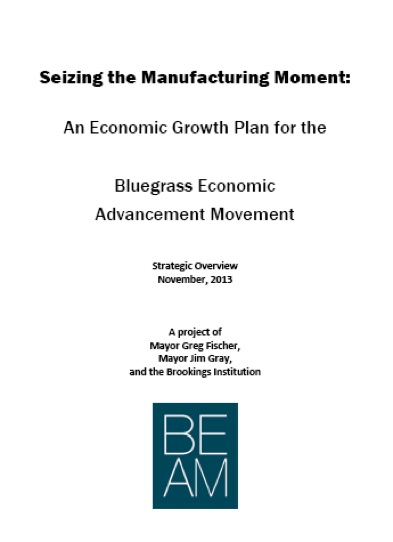
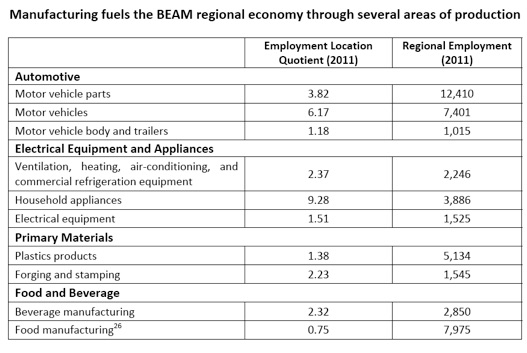


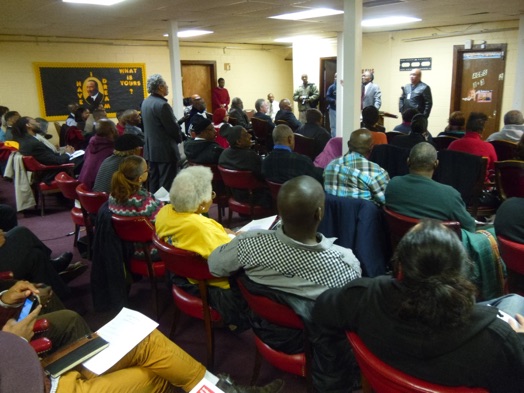
Mayor Fischer at the King Solomon Missionary Church in West Louisville
The $ 2.4 billion Bridges Construction Project

The intent appears to be to continue the program of intentional neglect as the ravages of poverty, drugs and over-enforcement marginalize and reduce the community cohesion in a wasting program.

WHY is It called BadwaterJournal ?
This blog originally focused on water pollution caused by sewer overflows. See some related pages HERE and HERE
I used the simple language ‘bad water’ to dispense with the hyper-technical terms that scientists use to describe the characteristics of bad water, such as ‘total dissolved solids’ or ‘fecal coliform colonies per mili-liter’. The intent was to inform with photographs taken along the streams in Jefferson County Kentucky USA about the problems of sewer overflows caused by unchecked development and undercapacity infrastructure. Typical residents needed to know more about the local streams where children wade.
Since the first articles on water pollution, the blog has morphed into a commentary on all aspects of local and national policy that have significant environmental impacts.
One of the differences between the BadwaterJournal and most other websites that cover environmental issues, is that it is the product of one person --not a board or team. I have written, edited and posted all the content since the first page. BadwaterJournal reflects my approach to governmental policy and environmental impacts. I am free to report the ‘unfortunate truths’ that lie at the intersection of capitalistic economic expansion and the exploited people and natural resources that get in the way. If you would like to support this work--please send a check in any amount. This is not tax deductible.

Make Payable to:
Bud Hixson,
Badwater Journal
mail to:
1336 Hepburn Avenue
Louisville, KY 40204
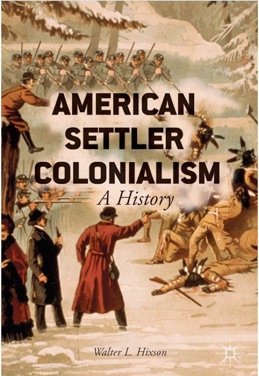
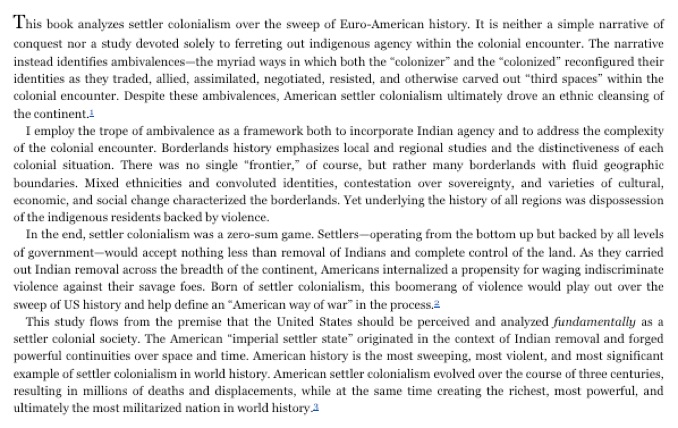
Fundamental insights in American history provide a framework for
understanding the present
Link to Amazon HERE


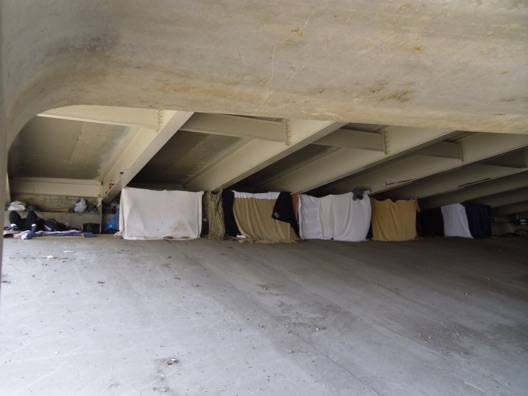
WALMART gets $ 1.8 million dollars in land and $ 500,000 incentives from city leaders to bring 300 minimum wage jobs to 18th and Broadway
With a host of dignitaries and developers flanking him Mayor Greg Fischer on Monday March 24, announced the construction of a WALMART Supercenter at 18th & Broadway touting it would bring 300 much needed jobs to the area.
The Rev. Kevin Cosby of the St. Stephens mega-church, President of Simmons College and Board member of the University of Louisville, was on hand to step forward and in an ironic mini-sermon, damned the WALMART with faint praise when he talked about what passes for “good times” in Louisville--”anytime you make a payment; anytime you meet a friend--good times; anytime you keep from going under; not being hassled, not being hustled---good times; just keeping your head above water, a temporary layoff--good times; easy credit to rip off’; scrunchin’ and survivin’--good times; standing in a chow line--good times; WALMART going up --good times.”
Perhaps the capable Reverend was trying to walk the line between those who claimed the WALMART was not right for West Louisville (because it doesn’t pay a living wage and full time employees will not be able to afford rental housing and will need to rely on a second job to make ends meet) and those who wanted to be able to shop for cheap goods made in foreign countries without having to drive to New Albany or Bashford Manor. All the well heeled lawyers, council persons and “community leaders” at the announcement enjoy incomes far above the “hard times” level the Rev. described.
Rev. Cosby heaped praise on Frank and Teresa Bridgewater the busy developers of TMG --who have built several multimillion dollar buildings for his own organizations --like the Family Life Center See more at <http://www.mardrian.com/> the St Stephens Prayer and Retreat Center and renovations of Simmons College.
Rev. Cosby praised the Bridgewaters for “not giving up until the WalMart went up” and called for beefed up investment instead of beefed up law enforcement to address the spectre of summer violence and “wilding” that was reported the past weekend. The Metro Housing Coalition in 2013 reported:
“The living wage in Louisville for an adult with one child is $17.27; for an adult with two children it is $21.59. Though these wages are sufficient to afford a two- or three-bedroom rental unit, the typical hourly rate for 68 percent of all workers is below $17.27 and only 20 percent of the employed workforce makes more than $21.59.”
WALMART is not expected to pay line workers anything close to $ 17.27 an hour. Rev. Cosby thus sent a mixed message appropriate to the circumstance. Economic health of the area in terms of the real conditions for thousands in poverty in West Louisville is not likely to be improved by the mega store and its monolithic capitalism.
Homeless people camping under the I-65 overpass
at Breckinridge Street last week

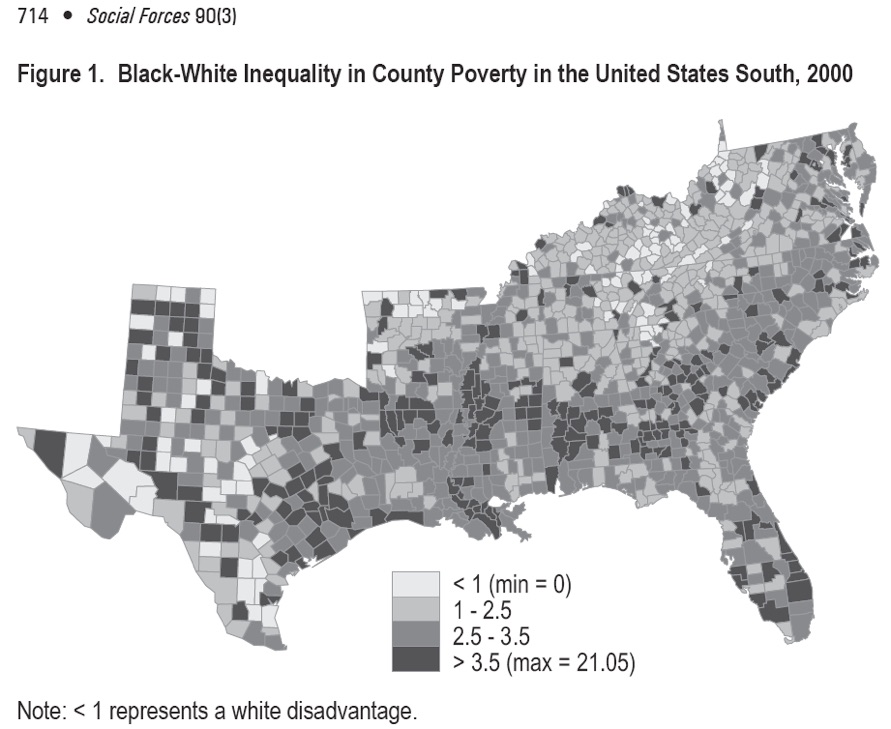
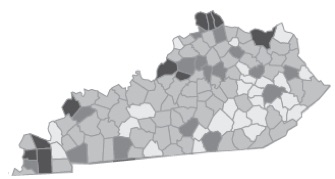

The Impact of Slavery on Racial Inequality in Poverty
in the Contemporary U.S. South
Heather A. O’Connell, University of Wisconsin, Madison
Social Forces 90(3) 713–734, March 2012
Despite Civil Rights legislation, racial inequality persists, especially in the context of poverty. This study advances the literature on racial inequality and the Southern legacy of slavery by examining slavery’s relationship with inequality in poverty. I analyze county-level U.S. Census data using regression and spatial data analysis techniques. I find the 1860 slave concentration is related to contemporary black-white inequality in poverty, independent
of contemporary demographic and economic conditions, racialized wealth disparities and racial threat. My research suggests the importance of slavery for shaping existing U.S. racial inequality patterns. Insights derived from this research, including the formulation of legacy as a place-based, continuous phenomenon that is distinct from racial threat, provide the basis for future research on legacy’s mechanisms.
Finally, although not directly addressed by my analyses I articulate two potential pathways through which slavery might be linked to the contemporary period. First, slavery might be associated with contemporary black-white inequality because local areas previously dependent on slavery continue to be dependent on exploitative economic
systems. Future research should examine the historical trajectory of economic development in local areas, including contemporary economic structures, to assess the extent to which slavery was replaced with subsequent exploitative economic systems as suggested in previous historical work (Royce 1985; Shifflett 1982). Second, the
legacy of slavery may indirectly affect economic disparities through its influence on educational and political institutions. The distribution of resources across and within schools in local areas with high historical concentrations of slaves may be such that blacks receive a lower quality education than whites and are therefore less qualified in the labor market. In addition, differential access to political power could affect local
blacks’ control over other aspects of their lives, such as their ability to bargain with employers for higher wages and their voice in the distribution of local resources (see Duncan 1999). Regardless of the mechanism, my results suggest researchers and policy makers concerned with racial inequality in poverty within the South should focus on places with a higher historical concentration of slaves.